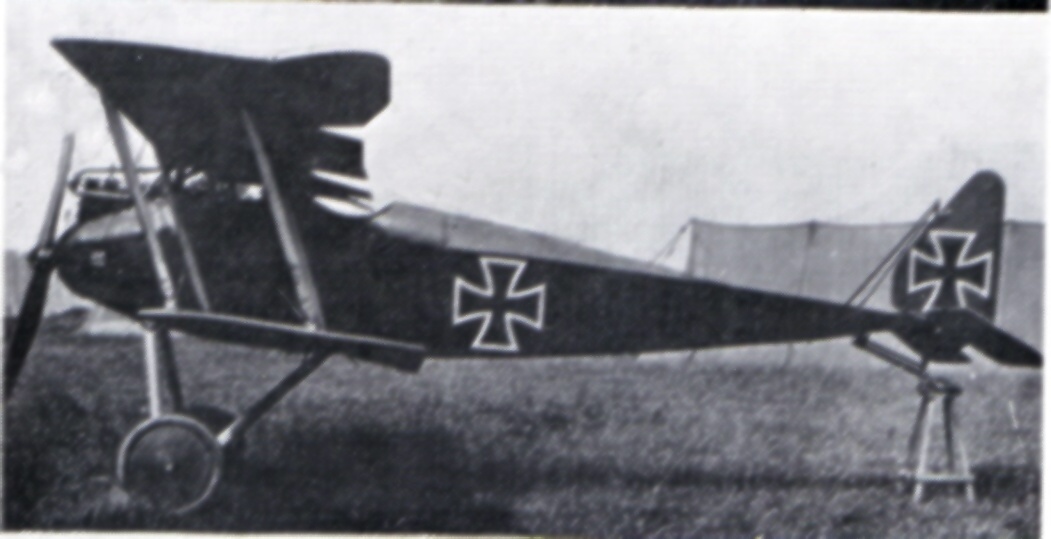- Halberstadt D.II
__NOTOC__ Infobox Aircraft
name = Halberstadt D.II
type = Fighter
manufacturer =Halberstädter Flugzeugwerke 
caption = Blue Halberstadt D.II flown by Boelcke
designer =
first flight = Late 1915
introduced = Early 1916
retired =
status =
primary user = Imperial German Army Air Service
more users =
produced = 1916
number built = 85
unit cost =
variants with their own articles =The Halberstadt D.II was a
biplane fighter aircraft of the Imperial German Army Air Service that served through the period of Alliedair superiority in early 1916, but had begun to be superseded in the "Jagdstaffeln " by the superior Albatros fighters by the autumn of that year.Design and development
The D.II was the production version of the experimental D.I. [Cheesman, p.134] Lightened to improve performance, it also featured staggered wings, and a more powerful 120 hp
Mercedes D.II engine. The side and frontal radiators that had been tried in the D.I were replaced by a wing mounted radiator similar to that later used by theAlbatros D.III and D.V. The two bay wings were very strongly braced, and the cockpit was raised in relation to where it had been on the D.I. This required a turtledeck to be built up on the rear fuselage to fair the cockpit into the lines of the fuselage. The wing trailing edge was a wooden member, as opposed to the wire common on contemporary German aircraft. Lateral control was byailerons , but there were no fixed tail surfaces, and over-sensitive Morane style balanced elevators similar to those employed by theFokker Eindecker were retained. [Grey & Thetford, p.147] Although it must have shared the typical "Morane" elevator sensitivity, and the controls cannot have been well harmonised, it was very manoeuvrable in skilled hands, and could be dived safely at high speed. [Munson p. 113] A single synchronised lMG 08/15 Spandaumachinegun fired through the propeller arc.If the only performance figures available for the type are accurate, the Halberstadt fighter’s speed and climb were little better than the Eindecker’s, and inferior to such Allied contemporaries as the
Nieuport 11 and the D.H.2, but it earned the respect of Allied fighter pilots, [Cheesman p.134] and was the preferred mount of the pilots of the early Jagdstaffeln, until theAlbatros D.I became available.Operational history
Like other early German fighter types, the D.II was at first supplied in ones and twos to the ordinary reconnaissance units or "Fliegertruppe" of the "Luftstreitkräfte", then gathered into small specialised fighter units – the
Kampfeinsitzerkommando s. When the first true fighter squadrons ("Jagdstaffeln ") were formed in mid-1916, the Halberstadt was initially the best fighter available, [Munson, p.113] and was used byOswald Boelcke to demonstrate his famous pioneering air fighting tactics (theDicta Boelcke ) to the new units. His Halberstadt was painted bright blue overall [Cheeseman p. 134] – probably the first instance of the gaudy personal finishes applied by German fighter pilots to their mounts for the remainder of the war.As the new Albatros fighters came into service the Halberstadts were quickly replaced, although a few survived into early 1917. [Gray & Thetford p. 148 state that according to the Inter-Allied Control Commission 100 were still in service in January 1917 - this seems more likely to refer to peak employment in September or October the previous year]
Manfred von Richthofen flew a red Halberstadt D.II for a few weeks in March 1917, after the spar of hisAlbatros D.III cracked in combat.Variants
The "D.III" and "D.IV" differed from the D.II mainly in having slightly enlarged, balanced ailerons, and were powered by the 120 hp Argus and 150 hp Benz engines respectively. The "D.V" was the last Halberstadt single-seat fighter of the war – it was designed specifically to compete with the Albatros, and had a streamlined nose with a small spinner. [Cheesman p. 134] None of these later types were built in large numbers, as they were notably inferior in most respects to the new Albatros types.
Operators
;flag|German Empire
*"Luftstreitkräfte "pecifications (D.II)
aircraft specifications
plane or copter?=plane
jet or prop?=prop
ref=
crew=one, pilot
capacity=
payload main=
payload alt=
length main= 7.3 m
length alt= 23 ft 11 in
span main= 8.8 m
span alt= 28 ft 11 in
height main= 2.67 m
height alt= 8 ft 9 in
area main=
area alt=
airfoil=
empty weight main= 519 kg
empty weight alt= 1,144 lb
loaded weight main= 728.5 kg
loaded weight alt= 1,606 lb
useful load main=
useful load alt=
max takeoff weight main=
max takeoff weight alt=
more general=
engine (prop)=Mercedes D.II six cylinder in-line
type of prop=
number of props=1
power main= 90 kW
power alt= 120 hp
power original=
max speed main=145 km/h
max speed alt= 90 mph
cruise speed main=
cruise speed alt=
stall speed main=
stall speed alt=
never exceed speed main=
never exceed speed alt=
range main=
range alt=
ceiling main=
ceiling alt=
climb rate main= 15 min to 3,000 m
climb rate alt= 9,850 ft
loading main=
loading alt=
thrust/weight=
power/mass main=
power/mass alt=
more performance=
armament=
* 1 × forward-firing Spandau LMG 08machine gun
avionics=ee also
aircontent
similar aircraft=lists=
List of military aircraft of Germany see also=
References
Notes
Bibliography
*
*
*
Wikimedia Foundation. 2010.
